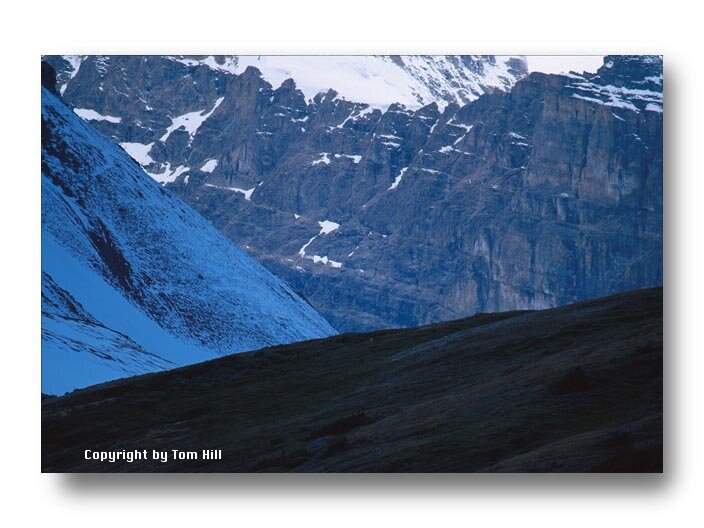
All Images And Text On This Site Are Copyright 1999-2000
by
Thomas D. Hill Jr.

Mountains at Jasper NP
I'm a big fan of subtle contrasts in light. Watching light colors transition to dark is especially pleasing to me. I'm particularly interested in seeing brightly light backgrounds overlapping with shaded foregrounds. Both of these pictures are explorations in this area. Unfortunately, really huge contrasts are severely limited by capabilities of the medium I choose to shoot--slide film. In most cases, slide film can accurately display 2 to 4 stops of contrast. A fairly limited latitude for any type of film and much less than what the human eye can see. Not enough light, you have no detail. Too much light, you've washed out the image. So exploring contrasts with slide film can be an exercise in futility.
This and Photo 995713 were taken within five minutes of each other on the Parker Trail. This trail allows particularly easy access to Banff's alpine tundra region. Normally you'd have to mount an expedition to climb to that altitude. On the Parker Trail however, after climbing 1,500 ft of vertical you'll find yourself above the treeline where nothing grows higher than a few inches above the ground. It's an inhospitable environment where the weather can change with little or no warning. The ragged spine of the Rockies is clearly visible at these altitudes and it makes particularly great photographic opportunities.
The day these images were taken was particularly stormy. Clouds would roll in, dump a bunch of rain, clouds would break allowing rays of light to highlight the terrain. Conditions where changing rapidly with the comings and goings of weather. I knew there was something to photograph in this environment but the challenge was to create an image that didn't exceed my film's latitude. Eventually, I settled on two compositions that I've posted here.
I have a lot of confidence with my F90x's matrix metering. Under most conditions it's spot on. This is especially true for situations were the medium tones are pervasive throughout the scene. If you lack confidence determining the overall tonal qualities of a scene, try turning your lens' focusing ring so that the image is so indecipherable that you're left with nothing but shades. Compare this shade with the standard 18% gray card. Now you have an idea of how much compensation you need for your camera. Except for really bright/white or extraordinarily black scenes you really don't have to apply too much compensation. That's pretty much the case with these two images. I setup the composition, figured out the overall tonal qualities, and depended on my camera's technology. This approach works about 85% of the time.
| CANADA GALLERY | UNITED STATES GALLERY | WHITE SANDS NM |
| COLD LAKE/LAKELAND | BOSQUE DEL APACHE NWR | WATERTON LAKES NP |
| MAIN INDEX |